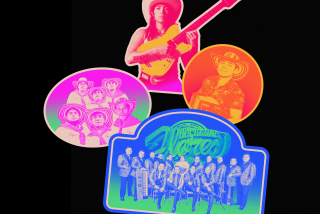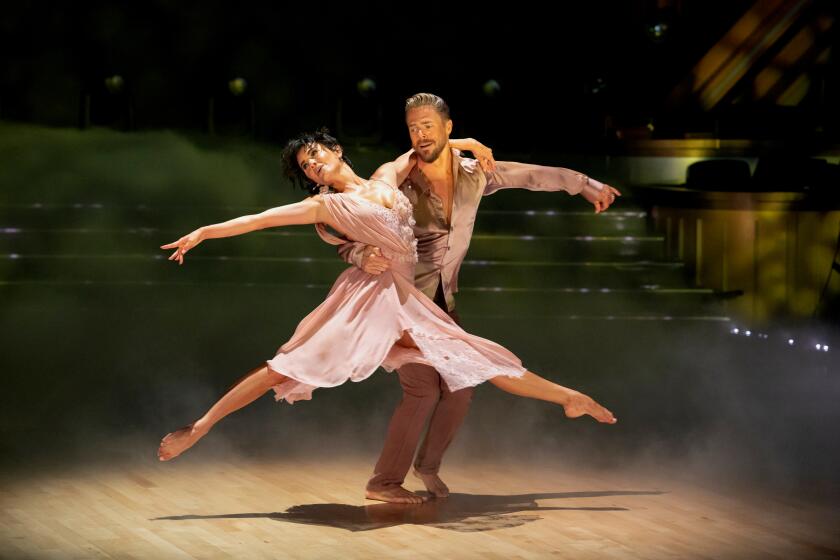Isle-Hopping to Americaâs Mainstream : Theater: Eduardo Machadoâs âFloating Islandsâ is a symbol for L.A.âs Cuban Americans who see their own stories reflected in the drama.
The Mark Taper Forum may be a long way from Miamiâs Little Havana, but lately it has become a gathering spot for Los Angelesâ Cuban Americans.
The draw is Eduardo Machadoâs epic drama, âFloating Islands,â the story of one clanâs journey from Cuba to the San Fernando Valley.
Presented in two parts, the production comprises four plays, beginning with âThe Modern Ladies of Guanabacoa,â which is set in a middle-class Cuban home in 1928. âIn the Eye of the Hurricaneâ and âFabiolaâ take place in the pivotal years of 1960 and 1961. And the final play, âBroken Eggs,â unfolds in 1980 Woodland Hills.
Filled with stormy domestic imbroglios and set against the backdrop of a country turned on its ear by revolution, the saga tells of one bourgeoise familyâs struggle, relocation and eventual assimilation into a new culture. It follows three generations of characters and takes more than six hours to perform.
Itâs based loosely on the playwrightâs own family history. Yet partly because so few plays about the Cuban experience have made it to mainstream stages, âFloating Islandsâ has become a symbolic moment of visibility for many Cuban American theatergoers who see their own story reflected in the drama.
One play canât, of course, be all things to all Cubans. Consequently, some feel it represents their experience well, while others are disappointed. But nearly all are pleased to see the presence of Cuban characters onstage.
âIt was a beautiful nostalgic trip,â says George Hernandez, director of post-production at Paramount Pictures, who left Cuba at age 7 and lived in Miami until he was 19. âIt was a satisfying tapestry of memories, reflective of a middle-class Cuban experience and also of my memories of my grandparents.â
âFloating Islandsâ also reflects the Angst.
âI was moved by the play,â says Al Nodal, general manager of L.A.âs Cultural Affairs department, who went to Miami from his native Cuba in 1957 and lived in Florida until 1972. âIt captured the Cuban ethos--the psychological torture that we all go through dealing with the loss of our homeland--in an elegant way.
âThe experience that we all share is displacement, and Eduardo did a good job of playing out the reasons for that,â Nodal continues. âIt captured feelings that we all have without getting overly political.â
In fact, the response to Machadoâs drama has been more cultural than political--probably because L.A. Countyâs Cuban American population, numbering approximately 50,000, tends to be less overtly partisan than its Florida counterpart.
âThereâs more diversity of points of view here,â Nodal says. âThereâs everything from people who support dialogue to die-hards for the embargo. There are some who support the revolution at this point, but a small amount.â
Yet those differences donât seem to matter when it comes to âFloating Islands.â And that is largely a matter of tolerance, especially when it comes to Machadoâs comparatively liberal agenda.
âCubans in L.A. have a more open attitude,â Hernandez says. âWe donât look at it only as Castro/anti-Castro. Thereâs more to life than hating Fidel Castro.â
Then too, the left-leaning tendencies of the entertainment industry skew the curve. âThereâs definitely a Latin network (in the entertainment industry), and a lot of them are Cubans,â says Carola Ash, director of development for actor and fellow countryman Andy Garciaâs production company. âBut because people are here for film, you tend to talk more about that than politics.â
Those who have little firsthand knowledge of revolutionary Cuba do praise Machado for raising the general consciousness of that time and place.
âI enjoyed it very much, particularly the first two stories,â says Ash, who left Cuba in 1964 at age 6, grew up in England, and has lived in L.A. for the past 2 1/2 years. âMy family was not a typical case, because my father was a writer, so it wasnât like he had a business that was taken away. But I know a lot of hard-working people whose property was taken from them.â
The one aspect of âFloating Islandsâ that consistently draws criticism, however, is the dramaâs prominent representation of homosexual incest.
âThere are some rough things . . . but that is part of the plot,â says Teresa Munoz Shaffer, who left her native Cuba in 1962, moved to L.A. in 1975 and works as an arts journalist for the Florida magazine Replica and the L.A.-based newspaper El Noticiero. âIt had nothing to do with the revolution. It has some political things in it, but itâs definitely not a political play.â
Others feel that Machadoâs work fails to evoke the richness of Cuban culture. âIt was lacking in a cultural basis,â says Armando Castro, manager of Hollywoodâs El Floridita restaurant, a Cuban community hangout since it opened in 1987. âThe music, literature and art is not in there. For being too long and sometimes boring, I would say it was incomplete.â
In that way, he says, âFloating Islandsâ fails to counter the ills of assimilation. âCubans here lose their culture (when) they come into the American stream,â says Castro, who emigrated from Cuba to Florida in the mid-1950s. âThe kids become Americans and go eat hamburgers. Eventually they donât even know what Cuban food is.â
The absence in L.A. of a specifically Cuban neighborhood like Miamiâs Little Havana also contributes to the disjuncture. âCubans in L.A. are all over the place geographically,â says Hernandez. âWe donât live in the same neighborhoods.â
Still, the same factors that mitigate against a unified identity also make L.A. Cubans hungry for their native culture. âYouâre never going to find a more Cuban group of Cuban Americans than the ones in L.A.,â says Hernandez. âBecause we are so far away from Miami and Cuba, we are almost like double exiles.
âWe are more appreciative of the cultural things because we donât have them easily accessible,â Hernandez continues. âIn Miami, itâs in every corner. Here, we have to look for it.â
* âFloating Islands,â Mark Taper Forum, 135 N. Grand Ave., Through Dec. 11. Pay-what-you-can performances are being offered Tuesday (Part One) and Wednesday (Part Two) and Friday (Part One) and Saturday (Part Two). Call for complete schedule of both parts. $28-$35.50 (each part), $56-$71 for both parts. (213) 972-0700.
More to Read
The biggest entertainment stories
Get our big stories about Hollywood, film, television, music, arts, culture and more right in your inbox as soon as they publish.
You may occasionally receive promotional content from the Los Angeles Times.










